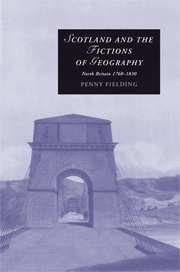Book contents
- Frontmatter
- Contents
- Acknowledgements
- Introduction
- 1 North Britain
- 2 Burns, place and language
- 3 Great North Roads: The geometries of the nation
- 4 Antiquarianism and the inscription of the nation
- 5 Ultima Thule: The limits of the north
- 6 Norths: James Hogg and post-Enlightenment space
- Notes
- Bibliography
- Index
- CAMBRIDGE STUDIES IN ROMANTICISM
1 - North Britain
Published online by Cambridge University Press: 05 May 2010
- Frontmatter
- Contents
- Acknowledgements
- Introduction
- 1 North Britain
- 2 Burns, place and language
- 3 Great North Roads: The geometries of the nation
- 4 Antiquarianism and the inscription of the nation
- 5 Ultima Thule: The limits of the north
- 6 Norths: James Hogg and post-Enlightenment space
- Notes
- Bibliography
- Index
- CAMBRIDGE STUDIES IN ROMANTICISM
Summary
In 1737, Thomas Gray, then a student at Peterhouse, Cambridge, was called upon to write some Latin verses to be issued at the University Tripos ceremony. In response, he produced ‘Luna Habitabalis’, a whimsical study that depicts a moon inhabited by various peoples curiously similar to those on Earth. At the instruction of one of the muses (presumably Urania, Muse of Astronomy), the speaker of the poem surveys the moon through a telescope while she directs him to ‘Look to the north!’, and he describes the course of his gaze:
Jam Galli apparent, jam se Germania latè
Tollit, et albescens pater Apenninus ad auras:
Jam tandem in Borean, en! parvulus Anglia nævus
(Quanquàm aliis longè fulgentior) extulit oras:
Formosum extemplò lumen, maculamque nitentem
Invisunt crebri Proceres, serùmque tuendo
Hærent, certatimque suo cognomine signant:
(II. 64–70)Presently the Gauls appear, then wide-spreading Germany rises into view, and white-topped father Apeninus towers aloft; finally, behold! Look to the north! tiny England, no bigger than a beauty spot (although brighter far than all other lands), offers its shores to view. Straightway throngs of princes come to see this lovely radiance, this shining dot, and continue looking far into the night; and each one vies eagerly to distinguish it with his name.
Gray's early flight of optical fancy as he ‘look[s] to the north’ has implications beyond its occasional purpose, and his positioning of England at a certain ‘north’ usefully brings together some of the themes of this book, hinting both at the aspirations behind the urge to locate and at the difficulties of location itself.
- Type
- Chapter
- Information
- Scotland and the Fictions of GeographyNorth Britain 1760–1830, pp. 13 - 39Publisher: Cambridge University PressPrint publication year: 2008

